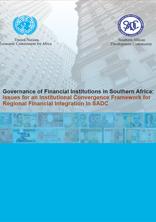Governance of Financial Institutions in Southern Africa

The Southern African Development Community (SADC) has an ambitious integration programme that includes establishing a regional central bank and monetary union in 2016; and a regional single currency in 2018. According to the SADC Regional Indicative Strategic Development Plan (RISDP), the community’s development framework, these initiatives constitute the deepest form of economic and financial integration, and are a part of a strategic push to integrate the region financially and economically.
With a mere seven years before the SADC monetary union is due for launching, there is a heightened realisation that the timeframes are tight, while the list of the remaining assignments is long. In a frank assessment recently, the SADC Committee of the Central Bank Governors (CCBG) Secretariat took note of the SADC achievements in macroeconomic convergence and financial integration (Belle, 2009) while drawing the attention of policy-makers to the need for policy changes if deadlines are to be met.
A number of Member States have shown good results towards meeting the macroeconomic convergence indicators, even if the global financial crisis has stalled greater progress. Nonetheless, given the volume of commitments still to meet, coupled with the seemingly poor state of readiness of Member States, and the obvious clash between the sub-regional and continental timeframes, it may be necessary to re-adjust the SADC integration timeframes.